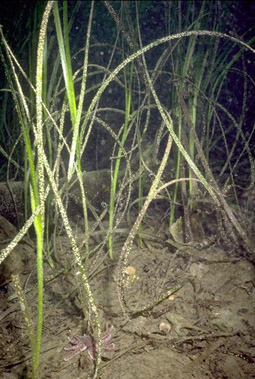Zostera
Zostera is a genus of seagrass in the family Zosteraceae, commonly known as marine eelgrass or simply eelgrass. The genus contains species that are found in temperate and subarctic coastal waters, often in marine environments. Zostera species play a critical role in coastal ecosystems, providing habitat, food, and nursery areas for a wide variety of marine life, including fish, crustaceans, and birds. They are also important in carbon sequestration, helping to mitigate climate change.
Description[edit | edit source]
Zostera species are perennial plants with long, narrow leaves that grow from a creeping rhizome. The leaves are typically bright green and can vary in length from a few centimeters to over a meter, depending on the species and environmental conditions. Zostera beds form dense underwater meadows that are highly productive and biologically diverse areas. These meadows offer protection from predators and serve as feeding grounds for many species.
Reproduction[edit | edit source]
Zostera reproduces both sexually and asexually. Sexual reproduction occurs through the production of flowers and seeds. Zostera flowers are small and inconspicuous, with separate male and female flowers that can be found on the same plant (monoecious) or on different plants (dioecious). Pollination takes place underwater, with pollen grains being released to float in the water until they reach a female flower. Seeds are then produced, which can be dispersed by currents or animals. Asexual reproduction occurs through the growth of the rhizome, which can produce new shoots and roots, leading to the spread of the seagrass meadow.
Ecological Importance[edit | edit source]
Zostera meadows are of significant ecological importance. They stabilize sediment, reduce erosion, and improve water clarity by trapping particulate matter. These meadows are also a key source of organic matter and provide oxygen to the marine environment through photosynthesis. Furthermore, Zostera acts as a critical habitat for many species, offering breeding grounds, nursery areas, and shelter. The decline of Zostera meadows in many parts of the world due to pollution, climate change, and physical disturbances has raised concerns about the loss of biodiversity and the degradation of coastal ecosystems.
Conservation[edit | edit source]
Efforts to conserve and restore Zostera meadows are underway in various regions. Conservation strategies include reducing water pollution, implementing marine protected areas, and direct restoration projects where Zostera seeds or shoots are planted to reestablish meadows. The success of these efforts is critical for the health of coastal ecosystems and the services they provide to human communities.
Species[edit | edit source]
The genus Zostera includes several species, such as:
- Zostera marina - Also known as common eelgrass, it is the most widespread species, found in the North Atlantic, North Pacific, and parts of the Southern Hemisphere.
- Zostera muelleri - Found in the Southern Hemisphere, particularly around Australia and New Zealand.
- Other species include Zostera noltii, Zostera japonica, and Zostera capricorni.
Navigation: Wellness - Encyclopedia - Health topics - Disease Index - Drugs - World Directory - Gray's Anatomy - Keto diet - Recipes
Search WikiMD
Ad.Tired of being Overweight? Try W8MD's physician weight loss program.
Semaglutide (Ozempic / Wegovy and Tirzepatide (Mounjaro / Zepbound) available.
Advertise on WikiMD
WikiMD is not a substitute for professional medical advice. See full disclaimer.
Credits:Most images are courtesy of Wikimedia commons, and templates Wikipedia, licensed under CC BY SA or similar.Contributors: Prab R. Tumpati, MD


